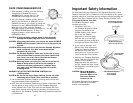
SUGGESTED COOKING TIMES
The following cooking times are provided as a guide to be
used when cooking in the Russell Hobbs® Electric Pressure
Cooker. Cooking times can vary depending on the quality
and the individual piece sizes of the food being cooked;
maximum and minimum cooking times are given in some
instances. Cooking time for vegetables will vary depending
on size, freshness, and variety of vegetables.
When uncertain how long to cook something, always start
with the shortest cooking time because you can always
continue cooking for additional time until the desired texture
is reached.
All cooking times listed begin once full pressure is reached.
Use your own heat-resistant steaming basket in the bottom of
the Pressure Cooker Pan to hold food while pressure cooking
or steaming.
FOODS THAT SHOULD NOT BE COOKED UNDER
PRESSURE ARE:
Applesauce, cranberries, rhubarb, macaroni, spaghetti or
other pasta, dried soup mixes, oatmeal or other cereals,
grains, pearl barley, split peas or any dried beans, peas or rice
not listed on the Cooking Charts. These foods tend to expand,
foam, or froth and may block the Pressure Lift Pin and Pressure
Regulator Valve’s Steam Vent Tube.
NOTE: The USDA recommends that ground turkey and chicken
be cooked to an internal temperature of 165ºF and
ground beef, veal, lamb and pork be cooked to an
internal temperature 160ºF. Meats such as beef and
lamb, etc. should be cooked to an internal temperature
of at least 145ºF. Pork should be cooked to an internal
temperature of at least 160ºF and poultry products
should be cooked to an internal temperature of 170ºF-
180ºF to be sure any harmful bacteria has been killed.
When re-heating meat/poultry products, they should
also be cooked to an internal temperature of 165ºF.
20
6. Wash the Pressure
Regulator under
running water.
7. Check spring-loaded
part before replacing.
8. Align the Pressure Regulator at the CLEAN position, press
down and turn clockwise to secure the Pressure Regulator in
place for storage.
9. When the unit has cooled after cooking, remove food residue
with a paper towel, then wipe with hot, sudsy sponge and
rinse. Dry with a soft cloth or paper towel. Never use harsh
chemical detergents, scouring pads or powders on any of the
parts or components of this Pressure Cooker.
WARNING: DO NOT IMMERSE THE PRESSURE COOKER PAN IN WATER
OR ANY OTHER LIQUID.
NOTE: Do not place the Pressure Cooker Lid, Pressure
Regulator Valve parts, Gasket or Pressure Cooker Pan
in the dishwasher.
10. Store the Pressure Cooker with the Pressure Cooker Lid off or
upside-down on the Pan. Do not store the Pressure Cooker
with the Pressure Cooker Lid and Gasket closed tightly on
the Pan.
11. For increased safety and best results, the Gasket and Pressure
Lift Pin Gasket should be replaced every 12 months. For
ordering information, call Consumer Service at 1-800-233-9054.
19
User Maintenance Instructions ( C o n ’ t . )


















